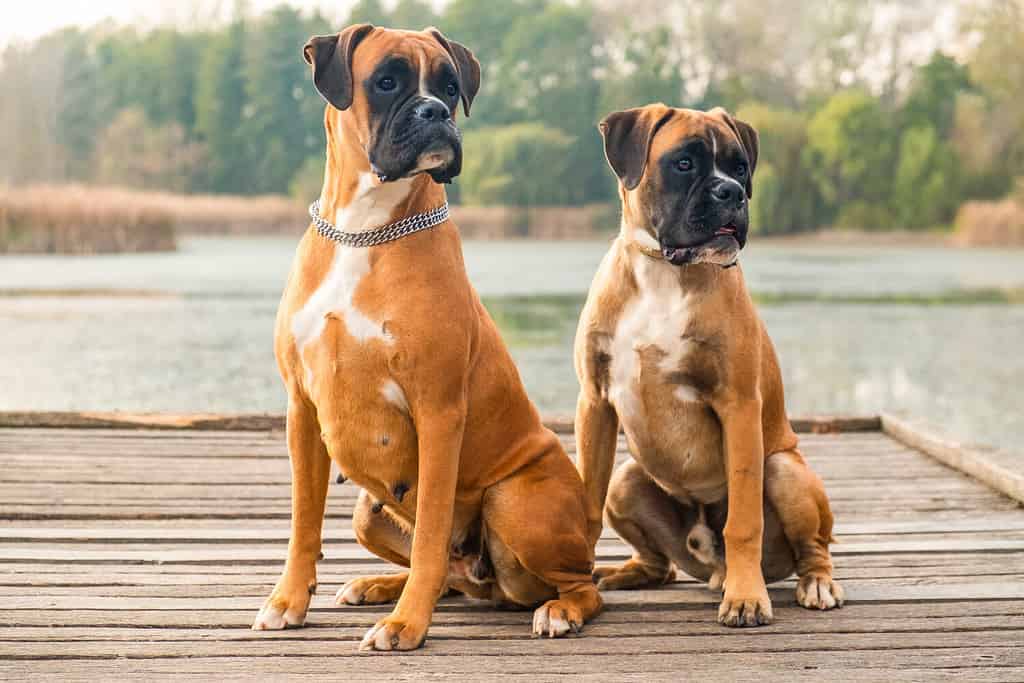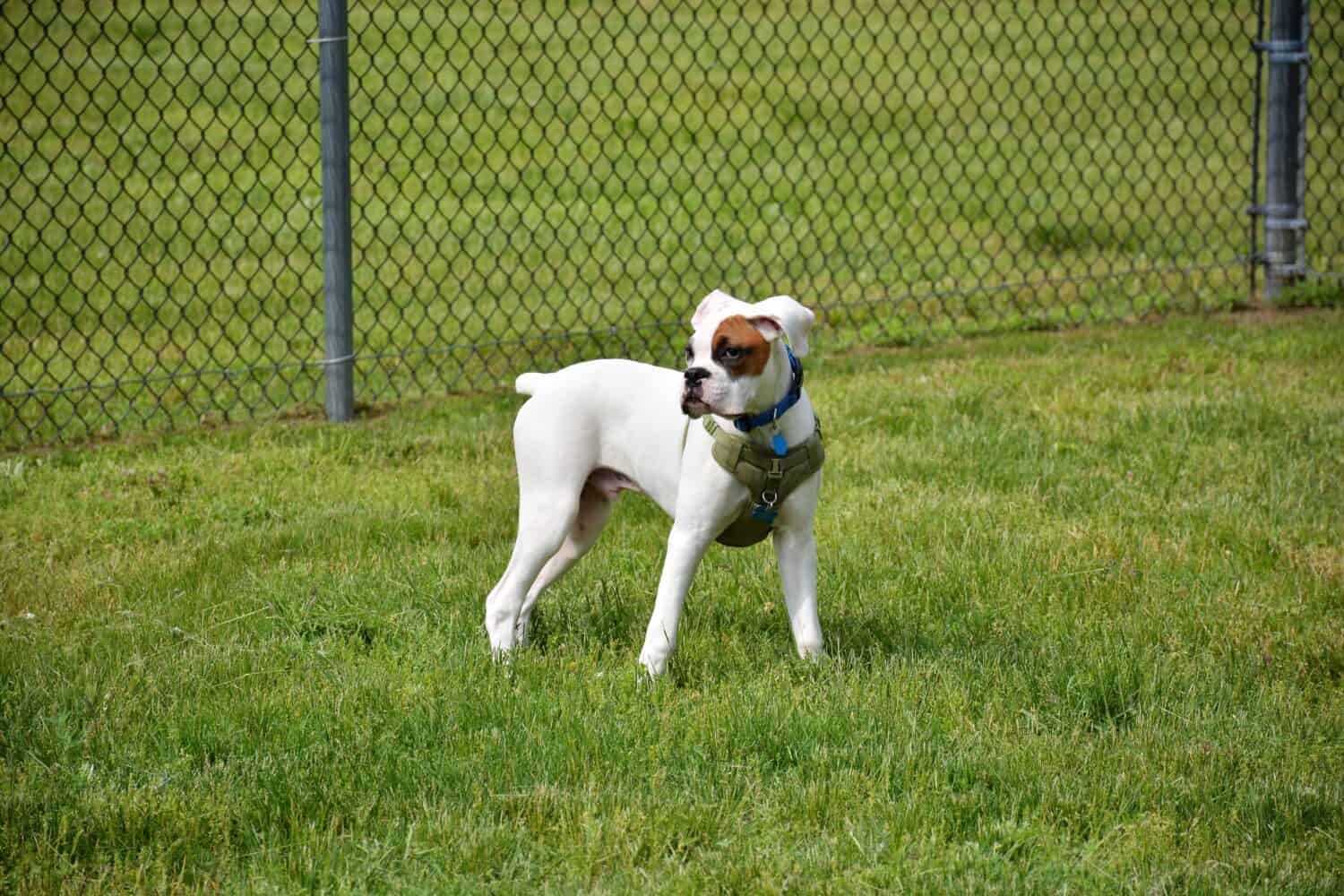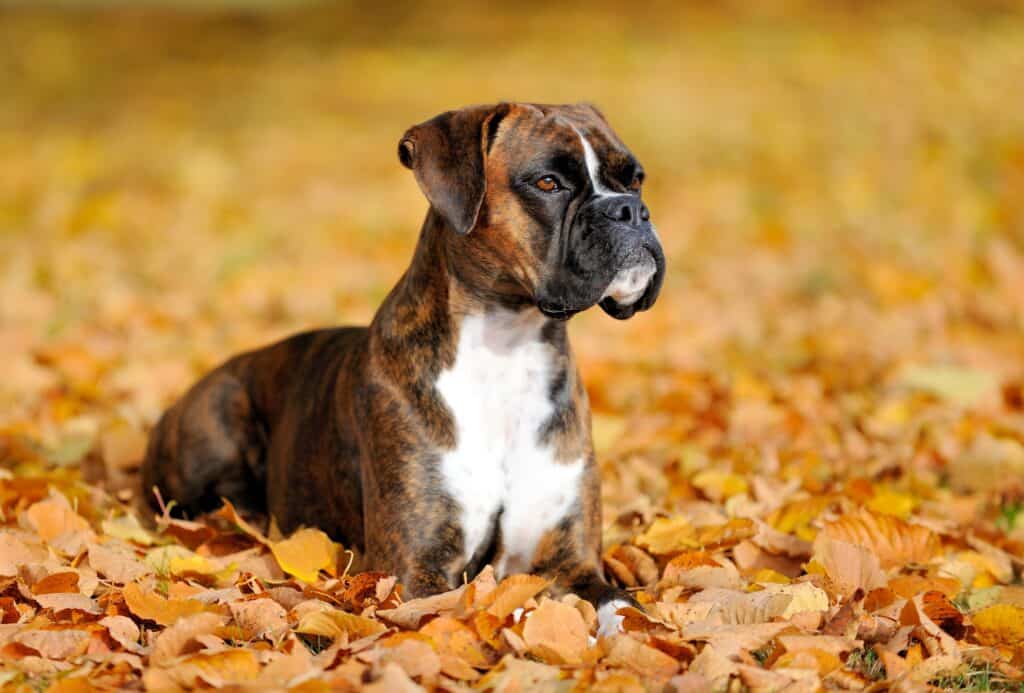Bringing home a new puppy can be joyful, exciting, and also a bit nerve-wracking. As the loving guardian of your new pup, you’ll want to make sure they reach healthy physical, emotional, and mental milestones and develop into a content dog who feels safe and secure. If you’re bringing home a new boxer puppy, you may wonder what to expect regarding their growth, developmental milestones, and how to train them ethically. Wondering about your boxer’s progression? Keep reading!
In this guide, we’ll cover what you can expect regarding growth and how to build a secure relationship with your pup to help it develop into a healthy, happy adult dog.
Read on to learn more!
Boxers: Breed Summary
In the late 19th century, German breeders developed boxers as a distinct breed. The ancestral breeds of the boxer include the Bullenbeisser (similar to the mastiff), the Great Dane, and the English bulldog. In 1895, a Munich dog club developed the first official breed standards for the modern boxer. From Germany, boxer breeding came to the US in the mid-20th century. Originally, these dogs were bred to hunt wild boar, deer, and bear. However, humans also exploited the strength of boxers by using them in the horrific, torturous “sport” of bull-baiting, in which boxers and bulls were forced to fight each other in pits.
Some Breed Standards
According to the American Kennel Club, the boxer is “a medium-sized, square-built dog of good substance with short back, strong limbs, and short, tight-fitting coat. His well-developed muscles are clean, hard, and appear smooth under taut skin”. From this broad definition, the AKC outlines extremely specific features that should be present in a boxer. For example, adult males should stand 23-25 inches tall at the very top of the shoulders, while females should stand 21.5-23.5 inches. Other requirements include the distinctly chiseled head, underbite, and blunt muzzle, which must fit precise measurements. The color of the coat must be either fawn, brindle, or, less commonly, white.

A boxer that conforms to AKC breed standards
© nik174/Shutterstock.com
Boxer Progression: Attributes
The breed of a dog doesn’t ensure specific attributes; however, research confirms that genes play some role in observed traits of specific breeds. For example, one study found inherent fetching behaviors to be quite consistently present in labrador retrievers. Other factors also play significant roles in influencing the behavioral development of dogs, such as environment, health, socialization during puppyhood, and how guardians raise and treat their pups.
Generally speaking, people who are guardians of purebred or mixed-breed boxers often describe them as wiggly, silly, energetic, and alert. It’s not uncommon for guardians to need a yard that has at least a 6-foot tall fence, as boxers are well-known for being able to jump or climb obstacles easily. Boxers can also be quite vocal as part of their behavioral expression.
It’s important to understand that some breeds are quite vocal, like huskies, and repressing that expression can be harmful. So if vocal, energetic pups aren’t for you, getting a boxer puppy might not be in your or the pup’s best interest. But, if you’re all in for a pup who may be quite high-energy, vocal, and who can likely clear a short fence, then a boxer may be a great fit for you. These pups can be wonderful matches with folks with an active lifestyle, low to no sound sensitives, and a go-with-the-flow type of outlook.
Boxer Progression: Growth and Weight Chart by Age
If you’re wondering what to expect regarding a boxer pup’s physical development, consult the chart below on average growth milestones. Our growth chart for assessing your pup’s development starts at 8 weeks, as puppies should not leave their mothers before this age.
| Age | Male Weight | Female Weight |
|---|---|---|
| 2 Months | 16-20 pounds | 12-18 pounds |
| 3 Months | 22-26 pounds | 18-24 pounds |
| 4 Months | 30-34 pounds | 26-32 pounds |
| 5 Months | 35-41 pounds | 32-38 pounds |
| 6 Months | 42-49 pounds | 39-45 pounds |
| 7 Months | 49-56 pounds | 46-52 pounds |
| 8 Months | 50-58 pounds | 48-55 pounds |
| 9 Months | 52-60 pounds | 50-57 pounds |
| 10 Months | 54-63 pounds | 52-58 pounds |
| 11 Months | 56-65 pounds | 53-59 pounds |
| 12 Months | 57-68 pounds | 53-61 pounds |
| 1.5 Years | 59-70 pounds | 53-65 pounds |
| 2 Years | 60-70 pounds | 55-65 pounds |
Boxer Progression: When Will My Boxer Stop Growing?
Typically, boxers reach full physical maturity between the ages of 18 months to two years. For many breeds, including boxers, you can expect they will continue to mentally and socially mature past 18-24 months, typically until they are 3-4 years old. Regular checkups with your vet, while your pup is growing can help you ensure your pup’s development is on track.
Outside of vet visits for vaccinations and any health concerns, it’s a good idea to visit your pup’s vet at the 6, 9, 12, and 24-month mark for development checkups. Always have fresh water available for your pup while growing and after reaching full maturity. How much food you feed per day will vary based on your pup’s age, but you can expect to feed an adult boxer between 3-5 cups of dry food per day.

You can expect your boxer puppy to stop growing around 18-24 months old.
©Peter Roslund/Shutterstock.com
Boxer Progression: How Big Will My Boxer Be When Fully Grown?
For a purebred boxer that meets the AKC breed standards, you can expect an adult male to stand 23-25 inches tall at the withers and weigh between 60-70 pounds, while females should stand 21.5-23.5 inches tall and weigh 55-65 pounds.
When Should My Boxer be Spayed or Neutered?
The question of when and if to spay or neuter a dog is individual to each dog. The issue of spaying and neutering is quite complex, with growing studies demonstrating increased risks of certain cancers developing for dogs that aren’t altered, such as mammary cancer, and studies showing increased risks of other types of cancers developing for some breeds of dogs that are spayed or neutered. Additionally, some research demonstrates a possible connection between altering some breeds of dogs with a host of other long-term health problems, such as urinary incontinence and diabetes mellitus. Neutering and spaying too young, especially for large breed dogs like boxers, can also possibly increase their risk of life-long joint and bone problems such as hip dysplasia.
In the US, this issue is also compounded by a crisis-level number of unwanted dogs forced to live as strays and enter shelters each year in conjunction with the dog breeding industry (especially backyard and puppy mills). In some countries without large stray or shelter populations, the benefits of keeping dogs intact can outweigh the possible risks associated with spaying and neutering. The issue is more complex in the US, as an average of almost 400,000 dogs are euthanized in shelters annually. If you can’t ensure that your boxer won’t breed, spaying or neutering can help decrease the number of litters that are continuously born.
Regarding the best time to spay or neuter your boxer, research supports delaying altering until they are at least 2 years old. Ultimately, you’ll find the best answer by consulting with a vet who is informed and up-to-date on the latest research regarding spaying and neutering.
Boxer Progression: When Should I Potty-Train My Boxer?
When bringing home a new puppy, it’s important to understand the connection between their age and how long they can hold their bowels. According to the Humane Society, young puppies can typically hold their bowels for as many hours as they are months old. So, a healthy two-month-old boxer puppy should be able to hold their bowels for about 2 hours and no longer. You can start the process of potty training at 8 weeks, but you need to keep in mind the limits of how long they can actually hold it.
So, the best way to ensure that your 8-week-old boxer puppy doesn’t have an accident indoors is to take them outside for at least 15 minutes before reaching this 2-hour mark. You can also use puppy pads inside, which are invaluable at night so you don’t have to get up every 2 hours.
When you bring your puppy outside to pee or poop, you want to mark that moment they go to the bathroom with lots of praise. You want them to know that going outside is a wonderful thing.
If Accidents Occur
If they have an accident indoors, it’s crucial to never punish your puppy (or adult dog). First, punishment is not supported by ethical dog training, and expert institutions like the American Veterinary Society of Animal Behavior only support the use of positive reinforcement and force-free training.
Punishment can have long-term detrimental effects on the development of your puppy and can damage your relationship. Additionally, by scolding your puppy, you aren’t actually teaching them what you’d like them to do. It only frightens the pup and teaches them that going to the bathroom in front of you is unsafe. So, they’re much more likely to use the bathroom in hiding places around your home where they feel safer. Instead of punishment, if your pup has an accident, calmly take them outside and praise them if they go. If they don’t, it’s no big deal, and you’ll probably just need to increase the number of times that you’re taking them outside.
Boxer Progression: When Will My Boxer Start Losing Teeth?
Your healthy boxer puppy should have 28 baby teeth that they will start losing around 4 months of age. At this time, new adult teeth will also start to come in. This can be an uncomfortable process that you can help alleviate by providing chew rings, frozen carrots, and similar safe items for your pup to teeth on. When your pup is 6 months old, his adult teeth should be fully in. If you notice your pup chewing on things they shouldn’t be, don’t scold them. Instead, offer a trade by giving them an appropriate item in exchange. Have plenty of items for them to chew during this period around the house.
When Should My Boxer Stop Eating Puppy Food?
As a larger breed dog, you’ll want to continue feeding your boxer puppy food until he’s between 12-15 months old. Feeding them puppy food until this age will best support healthy development and reduce their chances of developing conditions such as hip dysplasia. Look for food that contains a minimum of 22% protein and 8% fat.
What Cues Should I Teach My Boxer?
Modern, ethical training puts much more of an emphasis on developing a secure, healthy relationship with your pup and helping them navigate a human-dominated world. Instead of obedience training for your boxer puppy, it’s better to think about teaching them life skills and fostering a secure relationship. Some of these skills for a boxer include teaching the following cues (request, not command):
- “Come” (recall)
- “Drop it” (ideally in exchange for a treat or toy every time)
- “Wait” (a good skill for waiting to cross a street, hop out of the car, etc.)
- “With Me” (walking close to you in crowded or tricky environments)
Boxers are energetic and curious, and some enjoy chasing other animals. So ensuring your pup had a good recall, for example, is crucial to their health and safety and the safety of other critters.
A good recall cue means your puppy will consistently return to you when called at increasing duration, distance, and distraction levels. To start off, you’ll want to set the bar extremely low so you set your pup up for success. You’ll also want to set a foundation for using positive reinforcement so your puppy will be excited and motivated to participate in learning. You can start very short, gentle, and positive training sessions starting at 8 weeks old.

A trainer uses treats (a positive reinforcer) to teach a young boxer pup to walk next to her on a leash.
©Kyrylo Vasyliev/Shutterstock.com
Boxer Progression: Evaluating Unsuccessful Training Sessions
If you aren’t getting the results you want to see when teaching any cue or task, it simply means you need to take a pause and evaluate.
Perhaps you need to break the steps into smaller, more achievable pieces that your pup can understand better. For instance, if you’re teaching a “stay” cue, maybe you need just to shift your weight away from your pup and reward for them staying in place rather than taking multiple steps back. Or, you may need to decrease the length of the training session or distractions in the environment.
Additionally, the reinforcement you’re offering may not be high-value enough. Little pieces of cheese can be great for high-value training. Several other conditions can result in your pup not grasping a concept or feeling motivated but remember never to blame your pup or chalk it up to “bad behavior”. Just try to think about what your pup may need to have a more successful learning session.
Boxer Progression: Socialization
In addition to teaching skills such as “stay” and recall, socializing your puppy is extremely important. The crucial period for socialization is between 3 and 12 weeks of age when your puppy’s brain is wired to be curious and innately interested in new environments and social interactions. After 12 weeks of age, your pup’s brain doesn’t have as much capacity for taking in so much new information. So, if you wait until 12 weeks to socialize your pup, you have missed a critical window of social and emotional development.
The results can be long-lasting issues such as fear of novelties and increased anxiety or fear-based responses. Socialization should be gentle and supportive. One rule of thumb is to try to gently and positively introduce your boxer puppy to one new thing every day during the critical socialization period. Of course, you can help dogs become more comfortable in new environments after this timeframe, but their brains just aren’t as primed for it, so progress is typically much slower.

A boxer puppy snuggles a kitten during the crucial early socialization period.
©Ermolaev Alexander/Shutterstock.com
Boxer Progression: When Will My Boxer Calm Down?
You can expect your boxer puppy to go through quite an energetic puppyhood and adolescence. Boxers are often known as being energetic for much of their lives, but you may see a decrease in energy levels around 4 years of age. Note that if your pup’s mental, emotional, and physical enrichment needs aren’t being met, they can display hyperactivity, anxiety, and difficulty calming down throughout their life. Researching phrases such as “do no harm dog training”, “dog-centered care”, and “force-free and fear-free dog training” can help you find resources on supporting your pup.
Common Health Issues Your Boxer Might Experience
This breed is particularly prone to developing several cancers, including brain tumors, mast cell tumors, and lymphoma. Cardiomyopathy, which describes a heart condition that can result in irregular heartbeat, weakness, fainting, and, more rarely, sudden death, is another health issue some boxers endure. Boxers are also more susceptible to diabetes, hip dysplasia, and hypothyroidism.
Bi-yearly checkups, blood tests, and paying attention to any sudden development of growths, behavioral changes, or gait changes can help with early intervention on health issues.
Is a Boxer a Good Guard Dog?

Boxers are a brachycephalic breed and do not do well in hot or humid weather.
©Gabor Kormany/Shutterstock.com
Boxers belong to the Working Group of dogs, and as such, they are considered working dogs. One of the first breeds to be used as police and military dogs, as well as having been used as seeing-eye dogs, they were bred to be companion and guard dogs. This breed is known for its fondness for children and makes excellent family pets.
While they got their start as guard dogs, due to being a brachycephalic breed, they do not do well in hot or humid weather and this can be considered a health hazard to a working, or guard, dog. Although they may be capable of being a guard or watchdog, it is more beneficial to them if they are indoors. Boxers are also best as family and companion dogs, where their patient and protective nature enables them to guard over children.
Picture of Boxers as Puppies

Even as puppies, boxers love mental and physical challenges.
©cynoclub/Shutterstock.com
Picture of a Boxer at 6 Months Old

As with boxers of all ages, a 6-month-old boxer pup can also be quite vocal as part of their behavioral expression.
©vito natale/Shutterstock.com
Picture of an Adult Boxer

Adult boxers reach full physical maturity between the ages of 18 months to two years.
©larstuchel/Shutterstock.com
The photo featured at the top of this post is © volofin/Shutterstock.com
Ready to discover the top 10 cutest dog breeds in the entire world?
How about the fastest dogs, the largest dogs and those that are -- quite frankly -- just the kindest dogs on the planet? Each day, AZ Animals sends out lists just like this to our thousands of email subscribers. And the best part? It's FREE. Join today by entering your email below.
Thank you for reading! Have some feedback for us? Contact the AZ Animals editorial team.






